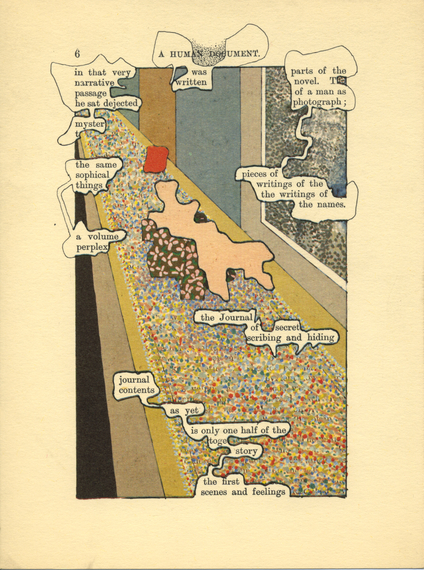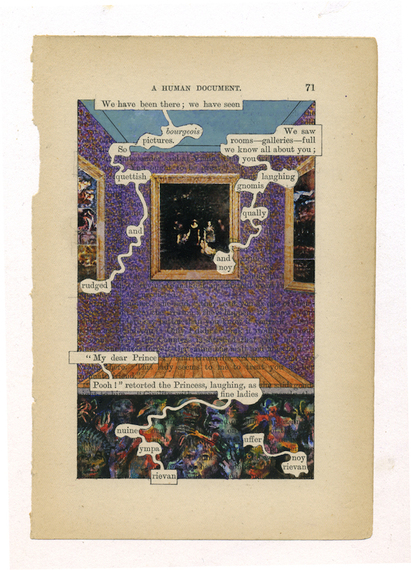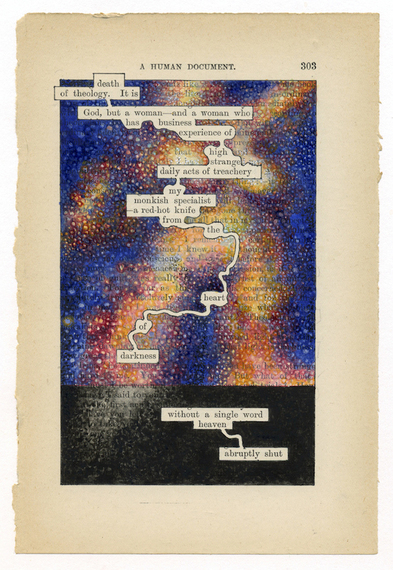Do you remember Jorge Luis Borges's story Pierre Menard, Author of the Quixote? In this one, from 1939, Borges postulates a man who spends much of his life precisely reconstructing, from vague memories of a youthful reading, extensive fragments of Don Quixote. This is about the speed that I tend to like my conceptual art - as literature.
I have a deep-seated problem with conceptual art, which is this: if it is indeed a concept, why not express that concept in the native language of concepts, the mighty word? Contrarily, if it requires instantiation in a visual art object, two paths may be taken.
Either the piece may be treated as a crafted physical object requiring discipline, skill, dedication, and quality, or it may simply be a vessel for the concept, adding nothing to the concept, at least nothing requiring the disciplines native to the visual arts.
The latter category seems to me to constitute the overwhelming majority of conceptual art, which shows execution ranging from the slapdash to the indifferent to the subcontracted. This latter category is the one I have a problem with. It transgresses visual art, enslaving it to an alien set of meanings, rendering it neutered, dusty, and eminently disposable. At best, it is funny - and it is often very, very funny. Sadly, I myself am not.*
Now, we leave open the former category: a naked concept to which the virtues of the visual arts have been applied. In the application, these virtues transform and enrich the concept until a unique entity has been created, which does indeed transcend the word.
Consider again Pierre Menard. Borges writes a story, rather than becoming Menard, because to become Menard amounts to madness. It would constitute the expenditure of unending labor on a pointless project.
Let me tell you another story, similar in texture to a Borges story. Two young men are going through the book bins at a flea market. One of them boasts that he will buy the next threepenny book he sees, and make of it a lifetime art project. The other one raises a skeptical eyebrow, perhaps, but sure enough, the braggart finds a likely book - for two pennies! - and buys it, and spends a lifetime transforming the book into an artwork.
This story really happened. On the 5th of November, 1966, Tom Phillips and R. B. Kitaj were thrifting in London. Phillips was the braggart. The book was A Human Document, a 19th century novel by W. H. Mallock. Phillips is still working on the project, hoping to complete it on its 50th anniversary. For his part, Kitaj has been dead these many years.
Menard comes to mind in connexion with Phillips, because Phillips has essentially performed an inversion of Menard's concept. Rather than laboriously recreating a text in its absence, he has laboriously obscured a text in its presence. Here is a page of his work:

A Humument, Page 6, Version 1, 1973, approx. 8" x 5.25"
image courtesy of the artist and Flowers Gallery, London and New York
In case it is unclear, what he has done is to make a drawing over most of a page of the source text, leaving only some words, of his own selection, legible. These words, however, are more than legible: they make sense.
This is, in an important way, conceptual art. The concept, I would posit, goes as follows: a text, any text, is like a river with a tremendously strong current - the linear order of the words. This current propels a casual reader forward along a single course, from start to finish. The word order provides an agreed-upon substrate through which a writer can convey a meaning, in the hopes that a reader will receive that meaning in the reading.
Phillips has found a functionally dead text, a book nobody remembers or reads anymore. The current lies latent on its pages, plaintively requesting a reader, but no reader makes himself available.
Phillips takes this text, and disciplines himself out of conforming with the current. He surveys the page not as a string of words, but as a field: not a river, but a becalmed sea. Its forward propulsion exploded, the page bobs up and down, and the eye of Phillips scans and scans it, slowly teasing out alternate potential texts. Those which please him, he preserves. The rest he destroys, covering it over with illustrations tangentially related to the stories he has discovered hidden in the book.

A Humument, Page 71, Version 2, 2010, approx. 8" x 5.25"
image courtesy of the artist and Flowers Gallery, London and New York
He did this with every page of A Human Document, which compressed under his controlled violence into A Humument. And then he did it a second time, teasing out an entirely different set of alternate texts, innovating new rivers inside the vast and directionless sea of the dead book.
What distinguishes this from category 2 conceptual art, the kind I don't like? The very qualities I ascribed to category one - the passion, the rigor, the discipline. The idea of Menard seems to be sufficient, without necessitating the existence of Menard. But the idea of Phillips is categorically inferior to the fact of Phillips.
There is something so touching, so baffling, and so creepily profound about his project, when one stands before it (only a small part of it is present at Flowers Gallery, the remaining displayed pages being high-quality facsimiles). Beyond the eccentric and delicate illustrations, and the Gorey-like prose, there is the palpable evidence that a man once thought it worthwhile to spend his entire life, the only life he's got, doing this. Why would he do that? What renunciation would it take? Would the book expand in the eye of its interpreter, so that the project of navigating it came to be indistinguishable from a normal life? Or would the entirety of life announce itself all too clearly as an extended process of dying? What pleasures would it yield, and what miseries? These questions could be posited without the existence of A Humument, but they would remain theoretical. As with Menard, one might feel free to close the book and write it off as an intellectual phantasmagoria. But the physical existence of A Humument prevents us from escaping so easily. It is that existence which is absolutely essential to the concept. It provides evidence that at least one person performed this absurd sacrifice, this outrageous indulgence, and thus demonstrated the real existence of one of the outer limits of reason itself.
It would have been very possible for no man to choose to do this, and the world would have got along OK. But there is some increment of spiritual wealth which Phillips and his vast and nearly pointless project have added to the treasure house of human accomplishment.

A Humument, Page 303, Version 2, 2010, approx. 8" x 5.25"
image courtesy of the artist and Flowers Gallery, London and New York
--
*tongue --> cheek
--
Tom Phillips: Pages from A Humument
Flowers Gallery
529 West 20th St., New York, NY 10011
www.flowersgallery.com
until August 29, 2015
